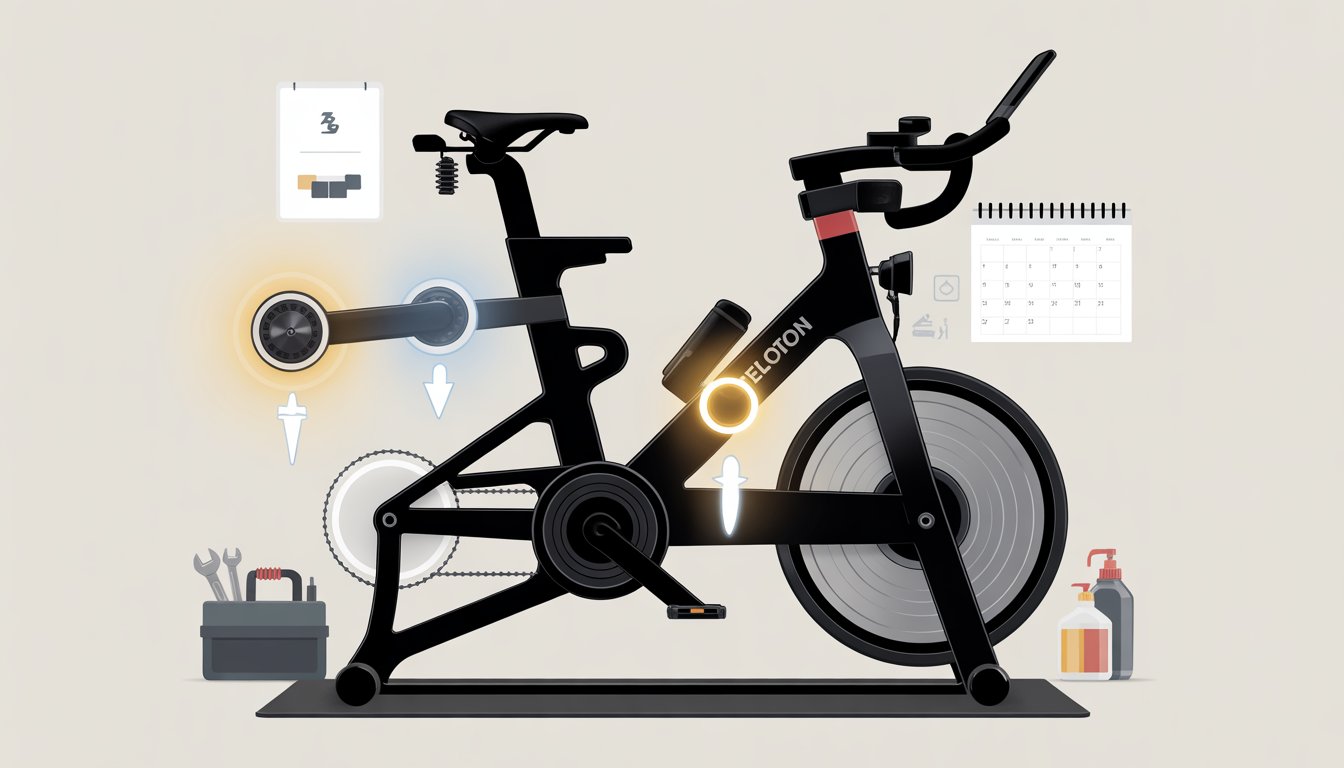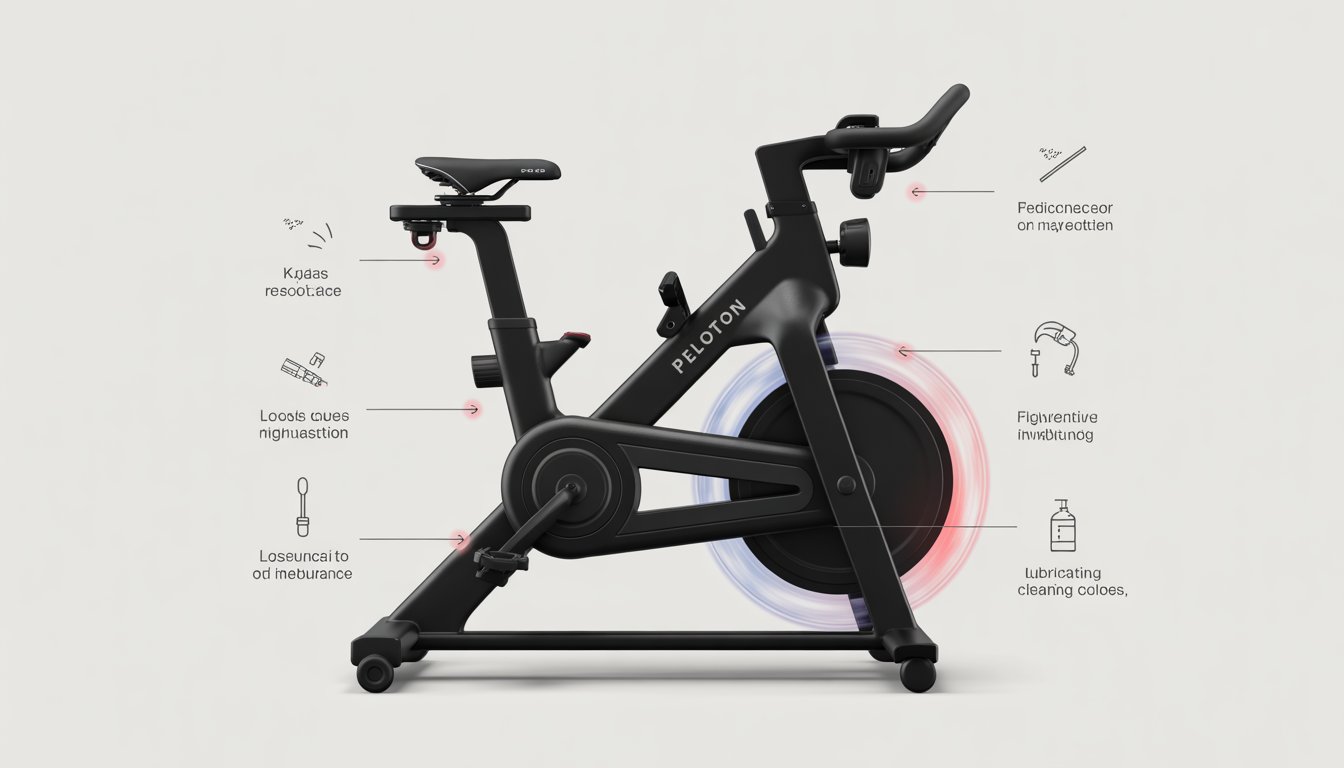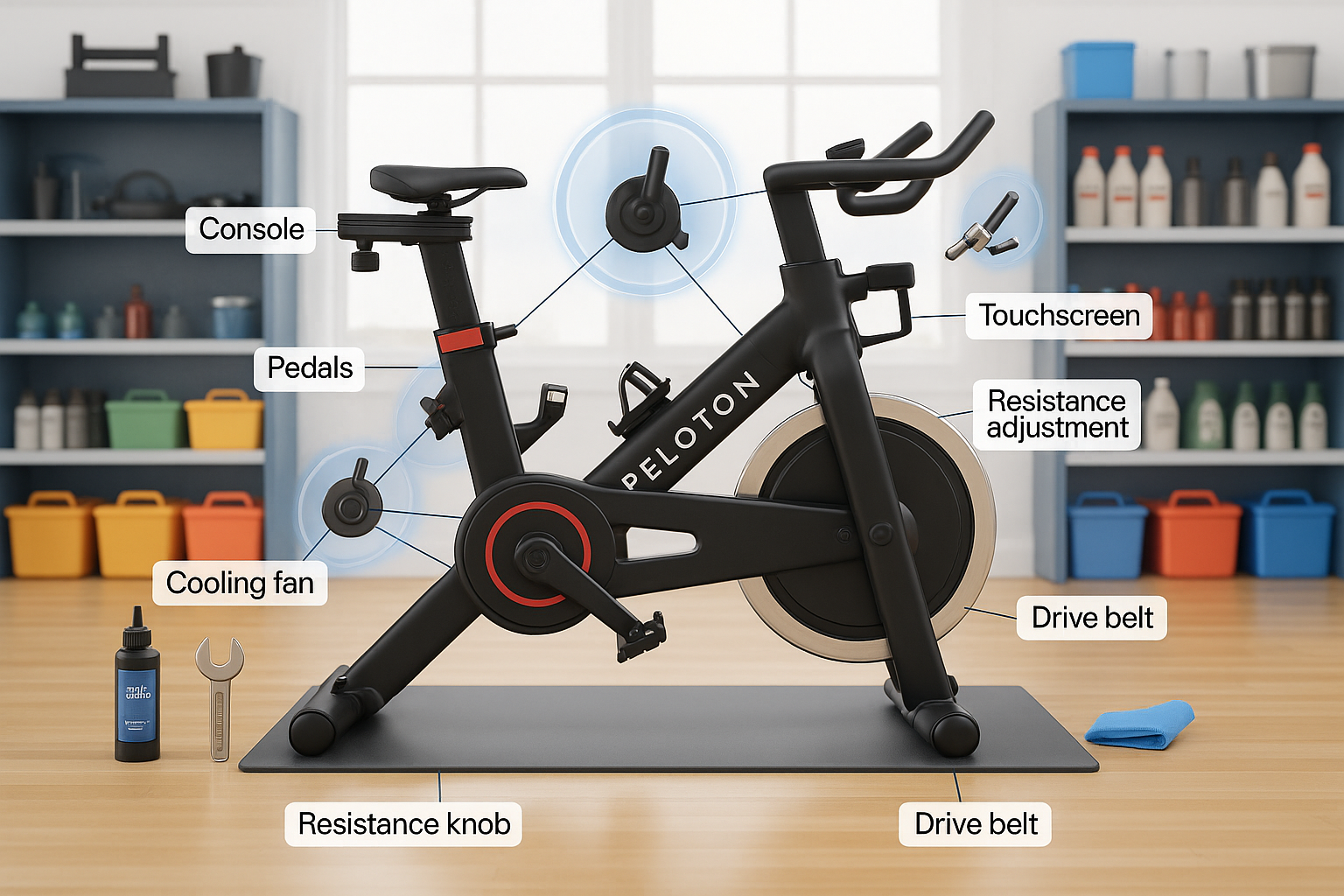Peloton bikes are built to last, but certain parts wear out faster than others due to regular use and mechanical stress.
Understanding which components fail most often can help riders save money and avoid unexpected breakdowns during workouts.

The most fragile parts that need regular attention are the pedals, flywheel bearings, and touchscreen.
Bearings typically last around 2,500 miles before requiring replacement.
Peloton bike owners can relate to maintenance challenges more than riders of traditional exercise bikes because of the unique magnetic resistance system and integrated technology.
Proper maintenance can extend the life of these components and prevent costly repairs.
This guide covers the warning signs to watch for, practical prevention strategies, and when to seek professional help to keep any Peloton running smoothly for years.
Key Takeaways
- Pedals, flywheel bearings, and touchscreens are the parts that fail most frequently on Peloton bikes
- Regular cleaning, calibration checks, and tightening loose components can prevent most common failures
- Following a monthly inspection schedule and addressing issues early saves money on expensive repairs
Most Commonly Failing Peloton Parts

Peloton bikes experience predictable wear patterns in three main areas.
The pedals and cleats break down from constant pressure, while the headset bearings fail due to design issues, and resistance knobs malfunction from heavy use.
Pedals and Cleats Wear and Failure
The pedals on Peloton bikes endure tremendous stress with every workout.
Riders clip in and out repeatedly, putting pressure on the pedal mechanism and cleats.
Common pedal problems include:
- Loose pedal threads that wobble during rides
- Worn cleat receptacles that won't hold shoes securely
- Cracked plastic housing around the pedal body
- Stripped threads where pedals attach to crank arms
Cleats wear out faster than pedals in most cases.
The metal cleats on cycling shoes develop rounded edges after months of use, making clipping in difficult and unsafe.
Signs of cleat wear include difficulty engaging with pedals and unexpected release during rides.
Most riders need new cleats every 6-12 months depending on usage frequency.
The pedal bearings also fail over time.
Riders notice grinding sounds or resistance when the pedal spins freely, which requires pedal replacement rather than repair.
Headset and Bearings Issues
The bottom bracket bearings on Peloton bikes have known design or manufacturing problems that cause frequent failures.
These bearings should last for years under normal conditions.
Bearing failure symptoms include:
- Clicking or grinding noises during pedaling
- Loose feeling in the crank arms
- Resistance that varies unexpectedly
- Wobbling in the pedal stroke
The headset bearings allow the handlebars to move smoothly during adjustments.
When these fail, riders notice stiffness or grinding when turning the handlebars.
Many owners report continual problems with bearing replacement on their bikes.
The bottom bracket may not seat bearings properly, leading to premature wear.
This issue affects both original Peloton bikes and the Bike+ models.
Professional service often becomes necessary since bearing replacement requires special tools.
Resistance Knob Malfunctions
The resistance knob controls the magnetic brake system that makes pedaling harder or easier.
This component sees heavy use during every workout as riders adjust difficulty.
Common resistance problems include knobs that turn but don't change resistance levels.
The magnetic brake may stick in one position or fail to engage properly.
Some riders experience clicking sounds from the resistance mechanism that won't go away.
This often indicates worn internal components in the magnetic brake system.
The resistance knob itself can become loose or wobbly over time.
The connection between the knob and the internal mechanism wears out from repeated twisting motions.
Resistance issues manifest as:
- Knob turns freely without changing difficulty
- Stuck resistance that won't decrease
- Inconsistent resistance levels during rides
- Physical looseness in the knob assembly
These problems typically require replacement of the entire resistance mechanism rather than simple adjustments.
Identifying Early Warning Signs of Part Failure

Catching problems early saves money and prevents complete breakdowns.
Strange sounds and loose parts are the most common warning signs that indicate your Peloton needs attention.
Unusual Noises or Vibrations
A clicking sound during rides often signals pedal issues or loose crank arms.
This noise gets worse over time if ignored.
Squeaking from the flywheel area usually means the belt needs attention.
The belt drive system should run silently during normal operation.
Grinding noises indicate more serious problems with internal components.
These sounds require immediate inspection to prevent damage.
Common noise sources include:
- Loose pedals creating rhythmic clicking
- Worn resistance knob causing scraping sounds
- Flywheel bearing issues producing humming noises
- Chain or belt problems creating squealing
Vibrations that feel different from normal workout intensity suggest loose bolts.
The bike should feel stable throughout all resistance levels.
New vibrations in the handlebars or seat post indicate mounting hardware needs tightening.
Regular Peloton bike maintenance prevents these issues from developing.
Loose or Wobbly Components
The seat post should never move side to side during rides.
Any wobbling indicates the clamp mechanism needs adjustment or replacement.
Handlebars that shift position signal loose stem bolts.
This creates safety risks and affects workout quality.
Pedals that feel loose or wobbly require immediate attention.
Continuing to ride with loose pedals can damage the crank arms permanently.
Check these components weekly:
- Seat adjustment levers
- Handlebar position locks
- Pedal tightness
- Base stabilizer feet
The resistance knob should engage smoothly without play.
Excessive movement in the knob indicates internal wear that affects resistance accuracy.
Screen wobbling during intense rides suggests loose mounting hardware.
The touchscreen should remain stable regardless of bike movement.
Transport wheels that rattle or don't roll smoothly need replacement.
These small parts prevent floor damage during bike moves.
Essential Preventive Maintenance Practices

Simple daily cleaning habits and monthly hardware checks can prevent most common Peloton failures.
Creating a consistent maintenance routine protects expensive components and extends bike life significantly.
Regular Cleaning and Sweat Management
Sweat is the biggest enemy of Peloton bikes.
Salt from sweat causes metal parts to rust and electronic components to fail over time.
Riders should wipe down the bike frame and touchscreen after every workout to prevent corrosion.
Clean water and a microfiber cloth work best for daily cleaning.
High-touch areas need extra attention:
- Handlebars and grips
- Seat and seat post
- Resistance knob
- Water bottle holder
- Tablet screen edges
Use disinfectant wipes on these areas every few rides.
Never spray cleaner directly on the screen or electronic parts.
The flywheel cover collects sweat drops during intense workouts.
Wipe this area after each session to prevent buildup that can damage internal components.
Place a towel over the handlebars during rides.
This simple step catches most sweat before it reaches bike parts.
Tightening Bolts and Adjusting Moving Parts
Loose bolts cause wobbling, noise, and premature wear on expensive parts.
Check all bolts monthly using the tools in your Peloton maintenance kit.
Key bolts to inspect:
- Seat post clamp
- Handlebar stem
- Pedal connections
- Stabilizing feet
- Water bottle cage
Turn each bolt clockwise until snug.
Don't overtighten as this can strip threads or crack plastic parts.
Moving parts need lubrication every three months.
Apply a small amount of bike grease to the seat post and handlebar adjustment points.
The resistance knob should turn smoothly.
If it feels sticky or makes grinding sounds, contact Peloton support immediately.
Check pedal tightness weekly.
Loose pedals can damage the crank arms, which costs hundreds of dollars to replace.
Proper Storage and Environmental Considerations
Room temperature and humidity directly affect bike longevity.
Keep your Peloton in a climate-controlled space between 65-75°F.
High humidity causes rust on metal parts and screen fogging.
Use a dehumidifier if your workout space feels damp or sticky.
Direct sunlight fades the screen and overheats electronics.
Position the bike away from windows or use curtains during sunny hours.
Storage checklist:
- Level flooring prevents frame stress
- 2-foot clearance on all sides for airflow
- Away from heating vents or air conditioners
- Protected from pet hair and dust
Clean the area around your bike weekly.
Dust and debris can get into moving parts and cause grinding or jamming.
Unplug the bike during thunderstorms or extended travel.
Power surges can damage the tablet and internal electronics permanently.
Recommended Maintenance Schedules and Intervals

Following a structured peloton maintenance schedule prevents most common failures and extends bike life.
Regular daily cleaning combined with weekly checks and monthly inspections keep critical components functioning properly.
Daily and Weekly Upkeep Tasks
After Every Workout:
- Wipe down the touchscreen and bike frame immediately
- Use disinfectant wipes on high-touch areas like handlebars and seat
- Turn off the touchscreen to prevent overheating
Cleaning the bike after use prevents sweat damage to metal components.
Sweat contains salt that causes corrosion over time.
Weekly Tasks:
- Check pedal tightness and tighten if loose
- Inspect cleats for wear or looseness
- Test the resistance knob by pressing it down
- Clean the heart rate monitor strap
Weekly seat and pedal maintenance catches problems early.
Loose pedals can damage threads and create safety issues.
Users should never skip daily cleaning.
Even one missed session allows sweat to start corroding parts.
Monthly and Yearly Inspections
Monthly Checks:
- Inspect all bolts and nuts for tightness
- Check seat adjustment mechanisms
- Examine handlebar connections
- Listen for unusual noises from moving parts
Every Three Months:
- Lubricate pedals for smooth operation
- Inspect flywheel, crank arms, and belt
- Check transport wheels and leveling feet
Annual Tasks:
- Replace pedals completely
- Deep clean all components
- Professional inspection if needed
Monthly inspections prevent small issues from becoming expensive repairs.
The most fragile parts are pedals, bearings, and screens, so these need extra attention.
Annual pedal replacement is essential even if they seem fine.
Internal wear isn't always visible but affects performance and safety.
Replacement Parts, Repairs, and Professional Support
Getting genuine parts and knowing when to handle repairs yourself versus calling professionals can save time and money.
Understanding Peloton's repair options helps maintain your bike properly.
Choosing Genuine Replacement Components
Peloton offers official replacement parts and tools through their website.
The company provides a complete tool kit with allen wrenches in multiple sizes and other essential tools for bike maintenance.
Users can purchase bike replacement parts by calling 866-679-9129.
This phone support helps identify the correct parts for specific models.
Common replacement parts include:
- Pedals (require regular replacement)
- Bearings (front bearings need frequent attention)
- Bottom bracket components
- Screen and electrical parts
Pedals should be replaced regularly to prevent failures from normal wear and tear.
This preventive approach reduces the risk of mid-workout equipment failure.
Genuine parts ensure proper fit and performance.
Third-party alternatives may not meet Peloton's specifications and could void warranty coverage.
When to DIY or Call for Help
Peloton provides step-by-step repair instructions for basic maintenance tasks. Simple jobs like pedal replacement and cleaning can be done at home.
DIY-friendly repairs:
- Pedal installation and removal
- Basic cleaning and lubrication
- Screen adjustments
- Cable management
More complex issues require professional help. Bearing replacements and bottom bracket problems often need expert attention.
Warranty coverage can affect your repair decisions. Peloton protection plans cover accidental damage and provide professional repair services.
Contact Peloton support for electrical problems, repeated bearing failures, or structural issues. These repairs require specialized tools and expertise.
Frequently Asked Questions
Peloton bike pedals should be replaced annually and cost between $40-60 for genuine parts. You can adapt regular shoes with toe cages or use cycling shoes with cleats for better performance.
What are the most common issues with Peloton bike pedals?
The most common pedal problems include loose connections that create clicking sounds during rides. Worn-out cleat mechanisms can also make it difficult to engage and disengage from the pedals.
Thread wear on the pedal arms develops over time from regular use. This creates instability and potential safety hazards during workouts.
Bearing deterioration inside the pedal mechanism leads to grinding noises and rough rotation. The most fragile parts include the pedals and bearing components that require regular attention.
How frequently should Peloton bike pedals be replaced for optimal performance?
Peloton bike pedals should be changed once a year for regular users. Heavy users who ride daily may need replacements every 8-10 months.
Weekly inspections help identify when pedals need attention. Check for loose connections and unusual sounds during each ride.
The replacement timeline depends on usage frequency and rider weight. Heavier users typically experience faster wear on pedal components.
What steps can be taken to maintain Peloton pedals and extend their lifespan?
Check pedals weekly to ensure they remain tight and properly secured to the crank arms. Loose pedals cause additional wear and potential damage.
Clean pedals after each workout with baby wipes to remove sweat and debris. Moisture buildup leads to corrosion and premature failure of metal components.
Lubricate pedal components every three months or after 100 hours of use. Proper lubrication reduces friction and extends bearing life.
Inspect cleats monthly for wear patterns. Replace them when grooves become shallow to maintain engagement quality.
What are the estimated costs for Peloton pedal replacements?
Genuine Peloton pedals typically cost between $40-60 per pair through official channels. Third-party compatible options range from $25-40 but may void warranty coverage.
Professional installation adds $30-50 to the total cost if you prefer technician service. Most riders can perform pedal replacements themselves with basic tools.
Cleats require separate purchases at $15-25 per pair. Complete pedal and cleat replacement costs approximately $75-85 for genuine Peloton components.
Can regular shoes be used with Peloton bike pedals, and what adaptation is required?
Standard Peloton pedals work exclusively with cycling shoes that have three-bolt cleat systems. Regular athletic shoes cannot directly engage with the pedal mechanism.
Toe cage adapters allow regular shoes to work with Peloton bikes. These cages attach to existing pedals and cost $20-30 for basic models.
Dual-sided pedals offer both cleat engagement and flat surfaces for regular shoes. These aftermarket options cost $50-80 and provide flexibility for multiple users.
Where can genuine Peloton replacement parts be purchased?
The official Peloton website is the best place to find genuine replacement pedals and components. This keeps your bike in top shape and protects your warranty.
If you need help, a qualified technician can handle parts replacement for you. Authorized service centers always use genuine parts.
Some third-party retailers offer compatible pedals, but they might not match Peloton’s standards. Sticking with original Peloton parts keeps your warranty safe.
Trust your investment to a master technician who knows you and your equipment. Note: Treadmill Maintenance Program coming soon!
The Concierge Maintenance Program includes:
Experience worry-free workouts with personalized service from a Certified Master Peloton Technician. Here's what you get with the program:
Thorough Inspection: David’s keen eyes and ears evaluate every inch of your bike and sound that it makes. This meticulous check ensures early detection of potential issues, preserving the bike’s lifespan and performance.
Hardware Integrity: Bolts, nuts, and screws on your Peloton bike’s screen, goose-neck, handlebars, cupholders, wheel cover, seat, inner and outer belt guards, stabilizers bars, foot pads, and nuts are inspected and tightened to precise specifications. This prevents unexpected loosening or breakages, providing a safe and sturdy workout environment.
Sensor and Resistance System Check: Ensuring these crucial components are working accurately guarantees your workout stats are reliable, and your resistance changes are smooth.
Front Hub and Axil Assembly Evaluation: This inspection safeguards the operational efficiency of your Peloton bike, ensuring smooth and fluid wheel movement.
Cadence Magnet Check: This ensures your pedaling speed is accurately tracked, enabling you to follow along with your workouts correctly.
Bottom Bracket Examination: Checking and tightening the bottom bracket to proper torque specifications ensures the bike’s structural integrity and prevents damaging wobble during intense workouts.
Touchscreen Optimization: By removing “bloat” data from the touchscreen memory, we enhance its responsiveness and speed, providing you a seamless user experience.
Belt Adjustment: A properly tightened and aligned belt ensures efficient power transfer from your pedaling to the bike’s mechanism, leading to an effective and smooth ride.
Crank Arm and Pedal Inspection: Tightening the left and right crank arms, inspecting pedals, and securing screw rivets ensures the stability of your pedal stroke, preventing potential injuries and maintaining bike longevity.
Proper Bike Calibration: This essential service ensures your bike’s resistance levels are accurate, offering you a consistent workout experience.
**Personalized Care: We’re always ready to answer any questions you may have, and are more than willing to look into any specific area of concern you may have with your Peloton equipment. Year round!
.png)

